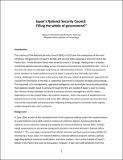Japan's National Security Council: filling the whole of government?
Author(s)
Fukushima, Mayumi; Samuels, Richard J
DownloadJapan's National Security Council REVISED #6 for Jen Greenleaf DSPACE.pdf (632.2Kb)
OPEN_ACCESS_POLICY
Open Access Policy
Creative Commons Attribution-Noncommercial-Share Alike
Terms of use
Metadata
Show full item recordAbstract
The creation of the National Security Council (NSC) in 2013 was part of the most ambitious reorganization of Japan's foreign and security policy apparatus since the end of the Pacific War in 1945. Prime Minister Shinzo Abe aimed to create a ‘Strategic Headquarters’ to better coordinate Japanese grand strategy across a fissiparous bureaucracy and political class. The formation of the NSC is a potential watershed in Japanese strategic policy-making. The improved crisis management, upgraded intelligence and centralized security policy-making that Japanese leaders hope to achieve through the NSC are indispensable if Japan is ever to resolve the inherent tension between its desire to enhance alliance management and its desire to reduce dependence on the United States. However, we conclude that the initial successes examined in this article may not be sustainable. Keywords: East Asia and Pacific Conflict; Security, and Defence; Russia and Eurasia
Date issued
2018-07Department
Massachusetts Institute of Technology. Department of Political ScienceJournal
International Affairs
Publisher
Wiley Blackwell
Citation
Fukushima, Mayumi and Richard J. Samuels. “Japan’s National Security Council: Filling the Whole of Government?” International Affairs 94, 4 (July 2018): 773–790 © 2018 The Author(s)
Version: Author's final manuscript
ISSN
0020-5850
1468-2346